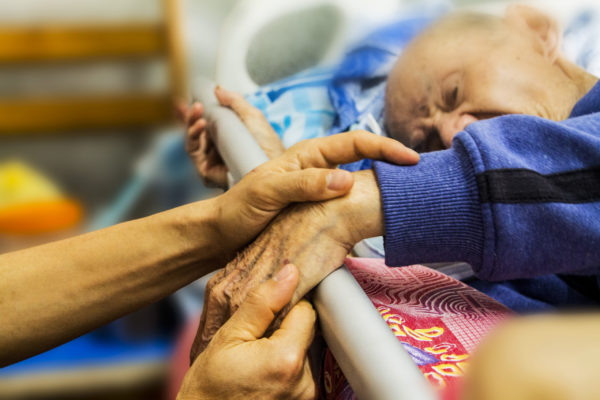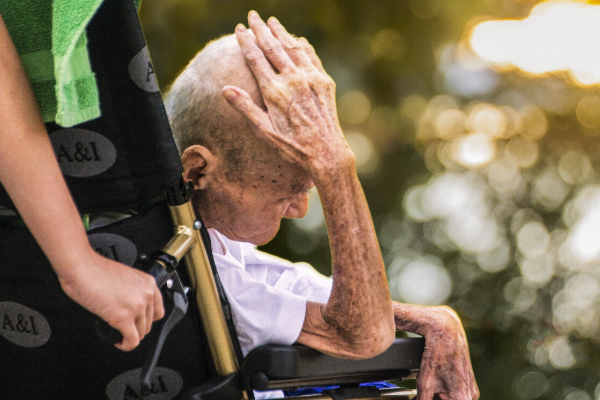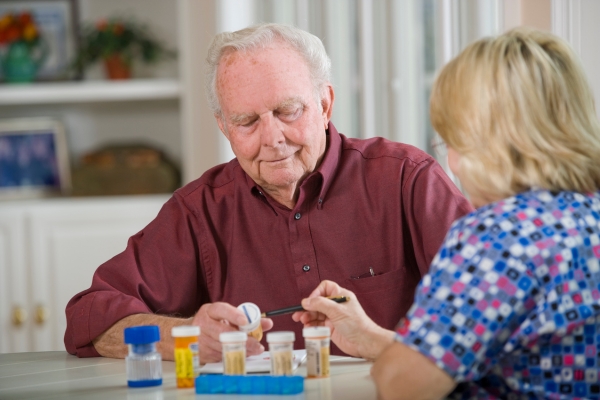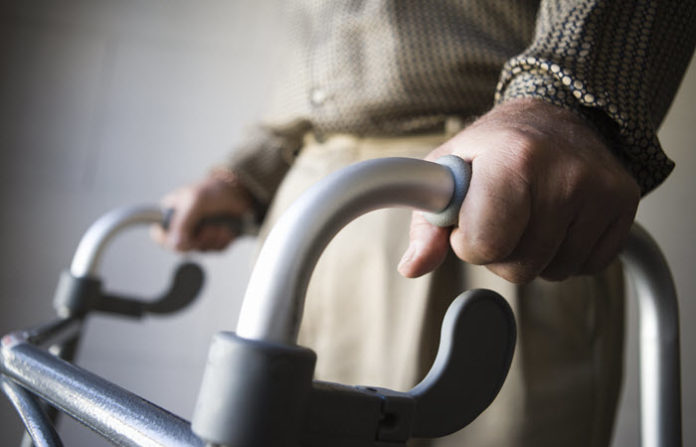Taking care of elderly people is never easy. Since they are more prone to infections (1), injuries, and changes in mental status, you have to be prepared and skilled when caring for them. If you are new to geriatric nursing, all these things can be intimidating and overwhelming.
So, to help you out, here are 3 nursing care plans for elderly you might find handy.
Risk for Falls

Risk Factors:
- Altered mobility
- Confusion
- Disorientation
- Malnutrition
- Skin breakdown
- Associated medical diagnoses (Alzheimer’s disease, blindness, cataracts, dementia, osteoporosis, osteomyelitis)
- Hearing difficulties
- Neuropathy
- Impaired balance
- Sleeplessness
- Environmental conditions
Desired Outcomes
- Doesn’t sustain fall
- Doesn’t experience any fall-related injuries
- Demonstrates preventive measures
- Implements strategies to prevent fall at home
| Nursing Interventions | Rationale |
| Assess conditions that can increase the patient’s level of fall risk, such as a history of falls, changes in mental status, sensory deficits, balance, medications, and symptoms related to diseases. | A proper assessment helps determine needed fall precautions. |
| Assess the patient’s environment for factors that can increase fall risk. | Unfamiliar environment and improper placement of furniture and equipment can increase patient’s risk for fall. |
| Orient to and stabilize the environment. | Elder patients may suffer from faulty short-term memory. Reorientation helps. |
| Provide for the safety and keep lights on at night. Make sure the call bell is available all the time. | Allows the patient to ask for assistance. |
| Have the patient wear a wristband identification to remind healthcare providers to implement fall precautions. | Enables healthcare providers to identify patients at an increased risk for falls. |
| Make sure that the patient’s bed is in the lowest position. Keep it as adjacent to the floor as possible. | Positioning the bed this way dramatically reduces fall risk. |
| Use side rails on the bed whenever needed and avoid using restraints. | Use of restraints doesn’t reduce the risk of falls (2). |
| Teach patients with unstable gait correct use of adaptive devices. | It decreases the potential for injury. |
| Make primary walkway as clear as possible. | Older patients may have a hard time walking around obstacles. |
| Evaluate patient’s medications and how they can cause falling accidents. | Identify drug interactions and side effects that can compromise the patient’s safety. |
| Encourage the patient to stay with the patient at all times. | Presence of family members can decrease confusion in patients with delirium. |
Activity Intolerance
Related to:
- Functional changes accompanying the aging process
Possibly evidenced by:
- Verbal report of fatigue or weakness
- Abnormal heart rate or blood pressure in response to activity, arrhythmia or ischemic changes on the electrocardiogram
- Presence of exertional discomfort or dyspnea
Desired outcomes:
- Vital signs remain within established parameters
- Modifies activities to adjust to decreased activity intolerance
- Seeks assistance in the performing Activities of Daily Living
- Experiences less discomfort when ambulating and performing other activities
- Verbalizes methods to reduce intolerance to activities
| Nursing Interventions | Rationale |
| Thoroughly assess the patient’s current physical activity and mobility. | This enables the nurse to obtain baseline data. |
| Determine the patient’s current medication intake. | Fatigue can be a side effect of certain medications. This includes tranquilizers, relaxants, sedatives, calcium channel blockers, and beta-blockers. |
| Get the patient’s baseline vital signs and oxygen saturation. | This will help determine the need for supplemental oxygen to aid the patient in the completion of activities. |
| Encourage the patient to perform activities more slowly. Provide frequent and longer rest periods if necessary. | Providing rest periods increases the patient’s tolerance for the activity. |
| Teach patient how to schedule activities for when they feel most energetic. | Plan activities to coincide with the patient’s peak energy levels. |
| Provide emotional support and acceptance of the patient’s abilities. Provide encouragement if the patient achieves even small improvements. | Depression is common among older people who experience limitations in their activities. |
Encourage patient to do energy conservation techniques, like:
| Energy conservation techniques help decrease the amount of oxygen needed by the body, enabling prolonged activity. |
| Establish progressive goals to increase ambulation | Activity level should be increased gradually. |
| If needed, provide adaptive equipment for Activities of Daily Living. | Reducing energy consumption, the use of adaptive equipment can enable the patient to achieve independence for doing self-care. |
See Also: 16 Fun Activities for Seniors and Elderly Patients
Disturbed Thought Process

Related to:
- Aging
- Hypoxia
- Malnutrition
- Head injuries
- Infections
- Medications
- Later-life depression
- Degenerative processes
Possibly evidenced by:
- Disorientation to person, place, and time
- Memory deficit
- Altered attention span
- Impaired ability to solve problems and make decisions
- Hallucinations
- Distractability
- Hypervigilance or hypovigilance
Desired outcomes:
- Recognizes changes in behavior
- Maintains proper orientation to time, place, and person
- Sustains no harm or injury
- Demonstrates strategies to cope with changes in health status
- Participates in activities
| Nursing Interventions | Rationale |
| Assess attention span and ability to make decisions. | Determines the patient’s ability to participate in planning and executing care. |
| Check the ability to send, receive, and interpret information. | Helps assess the degree of impairment. |
Identify factors that can contribute to the condition, like:
| Identifying factors can help determine the causative factors. |
| Perform frequent assessment of neurologic status. | Early recognition allows modifications of the plan. |
Orient patient to reality as needed:
| Reality orientation fosters awareness of self and environment. |
| Keep items in the same places. | Creates a consistent and stable environment which reduces confusion and frustration. |
| Protect the patient from sensory overload and allow for frequent rest periods. | Sensory overload may increase confusion. Frequent rest periods help avoid fatigue. |
| Encourage memories and discussion of past events. | Promotes a sense of continuity and aids in memory |
| Provide close supervision. | Prevents patient from wandering off or incurring harm |
| Encourage patient to voice feelings and concerns about memory loss. | Help reduce anxiety and ventilate frustrations |
| Speak slowly and clearly. Allow ample time for the patient to respond. | Reduces confusion and aids in task completion |
| Plan the patient’s routine and follow it as consistently as possible. | Reduces confusion and frustrations and aids in task completion |
Nursing Interventions for Elderly Patients:
Assess and Address Physical Limitations:
- Perform a comprehensive physical assessment to identify any age-related physical limitations or impairments.
- Provide assistance with activities of daily living (ADLs) as needed, such as bathing, dressing, and grooming.
- Implement fall prevention strategies, including the use of assistive devices and ensuring a safe environment.
- Assess and manage chronic pain conditions, considering age-related changes and comorbidities.
- Collaborate with physical and occupational therapists to develop and implement appropriate exercise and mobility programs.
Cognitive Function and Mental Health:
- Evaluate the patient’s cognitive function and screen for cognitive impairments, such as dementia or delirium.
- Create a calm and supportive environment for the patient to promote mental well-being.
- Use strategies to enhance communication and understanding, such as speaking clearly, using simple language, and providing visual cues.
- Collaborate with the healthcare team and involve family members in creating a care plan for patients with cognitive impairments.
- Assess and address mental health concerns, such as depression or anxiety, and provide appropriate referrals for counseling or therapy.
Medication Management:

- Conduct a thorough medication review, including assessment of medication adherence, potential drug interactions, and side effects.
- Simplify medication regimens and provide medication organizers or reminders to enhance compliance.
- Educate the patient and their caregivers about medication administration techniques, potential risks, and the importance of adherence.
- Collaborate with healthcare providers to adjust medication dosages or regimens based on the patient’s specific needs and potential age-related changes.
Nutrition and Hydration:
- Assess the patient’s nutritional status and screen for malnutrition or dehydration risks.
- Collaborate with a dietitian to develop a personalized nutrition plan that accounts for age-related changes, dietary restrictions, and comorbidities.
- Educate the patient and caregivers about the importance of a balanced diet, proper hydration, and the need for regular meals and snacks.
- Monitor the patient’s weight and nutritional intake, and address any concerns or barriers to adequate nutrition.
Preventive Care and Health Promotion:
- Provide age-appropriate screenings and vaccinations, such as influenza and pneumococcal vaccines.
- Educate the patient and caregivers about the importance of preventive care, including regular health check-ups, eye and dental exams, and cancer screenings.
- Promote healthy lifestyle choices, including regular physical activity, tobacco cessation, and moderation in alcohol consumption.
- Provide education on the prevention and management of chronic conditions common in the elderly, such as diabetes, hypertension, and cardiovascular disease.
Social Support and Engagement:

- Assess the patient’s social support network and address any feelings of isolation or loneliness.
- Encourage participation in social activities, community programs, or senior centers to enhance social interaction and mental stimulation.
- Facilitate communication and involvement of family members in the patient’s care, considering their role as caregivers or decision-makers.
- Provide resources and referrals to support groups or community services aimed at improving the patient’s social well-being.
End-of-Life Care:
- Initiate conversations about advance care planning and end-of-life preferences.
- Collaborate with the patient, their family, and the healthcare team to develop an individualized care plan that respects the patient’s wishes and values.
- Provide emotional support and guidance to patients and families during difficult conversations and decision-making processes.
- Coordinate with palliative care or hospice services when appropriate, ensuring a holistic approach to care at the end of life.
References:
1. Beeson, P. B. (1985). Alleged susceptibility of the elderly to infection. The Yale journal of biology and medicine, 58(2), 71.
2. Sze, T. W., Leng, C. Y., & Lin, S. K. S. (2012). The effectiveness of physical restraints in reducing falls among adults in acute care hospitals and nursing homes: a systematic review. JBI Database of Systematic Reviews and Implementation Reports, 10(5), 307-351.
Doenges, M. E., Moorhouse, M. F., & Murr, A. C. (2019). Nurse’s pocket guide: Diagnoses, prioritized interventions, and rationales. Philadelphia: F.A. Davis.



















